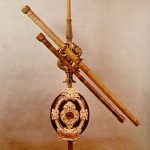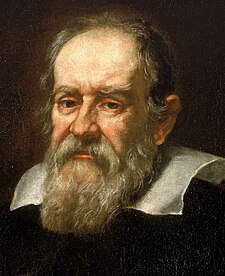Galilean telescope
The original design Galileo came up with in 1609 is commonly called a Galilean telescope. It uses a convex objective lens and a concave eyepiece lens. Galilean telescopes produce upright images.
Galileo’s best telescope magnified objects about 30 times. Because of flaws in its design, such as the shape of the lens, the images were blurry and distorted. Despite these flaws, the telescope was still good enough for Galileo to explore the sky. The Galilean telescope could view the phases of Venus, and was the first to see craters on the Moon and four moons orbiting Jupiter. – via source
 Galileo Galilei (15 February 1564[2] – 8 January 1642)[1][3] was an Italian physicist, mathematician, astronomer, and philosopher who played a major role in the Scientific Revolution. His achievements include improvements to the telescope and consequent astronomical observations, and support for Copernicanism. Galileo has been called the “father of modern observational astronomy,”[4] the “father of modern physics,”[5] the “father of science,”[5] and “the Father of Modern Science.”[6] Stephen Hawking says, “Galileo, perhaps more than any other single person, was responsible for the birth of modern science.”[7] – via source
Galileo Galilei (15 February 1564[2] – 8 January 1642)[1][3] was an Italian physicist, mathematician, astronomer, and philosopher who played a major role in the Scientific Revolution. His achievements include improvements to the telescope and consequent astronomical observations, and support for Copernicanism. Galileo has been called the “father of modern observational astronomy,”[4] the “father of modern physics,”[5] the “father of science,”[5] and “the Father of Modern Science.”[6] Stephen Hawking says, “Galileo, perhaps more than any other single person, was responsible for the birth of modern science.”[7] – via source



1 Comment to 'Galileo’s Telescope – Google Doodle'
2 September 2009
interesting post.. keep up